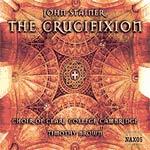
Stainer: Crucifixion (The)
 $25.00
In Stock
add to cart
$25.00
In Stock
add to cart
JOHN STAINER
Stainer: Crucifixion (The)
Simon Bailey (bass) / Stephen Farr (organ) / James Gilchrist (tenor) / Clare College Choir, Cambridge / Tim Brown (conductor)
[ Naxos / CD ]
Release Date: Tuesday 14 June 2005
"Lovers of English choral music will relish this highly attractive release"
- MusicWeb June 2005
Sir John Stainer was organist of St Paul's Cathedral and professor of music at Oxford, but he made it his special vocation to provide good music for parish choirs of moderate abilities, publishing a large number of anthems, chants and hymn tunes with this end in view. Though undoubtedly there was a financial motive, the cult of simplicity also suited Stainer's temperament and philosophy. He made himself an expert in the art of drawing emotion and depth of meaning out of commonplace melody and harmony.
In 1887 Stainer conceived the novel idea of writing music for Passion Week that was well within the reach of village choirs. The librettist, W.J. Sparrow-Simpson (1859-1952), was the son of a colleague at St Paul's, and the first performance was at St Marylebone Parish Church in London. The Crucifixion was not only well received, but has outlived almost all church choir music of its period, becoming a great popular favourite in the teeth of astoundingly harsh judgements by some critics and historians. The qualities that have endeared it to many generations are those that Stainer had consciously cultivated as a happy medium between contrapuntal elaboration and melodramatic tone-painting.
Stainer was writing at a time when Bach's Passions had been only recently introduced to the British oratorio public, and had at last dislodged Handel from his place as the unquestioned master of sacred choral music. The Crucifixion followed the Lutheran Passions in several respects. Never an oratorio, it was a 'Meditation', designed to form an integral part of an Anglican service, using the normal resources of choir and organ, and bringing in the congregation in several simple hymns (though Stainer composed new tunes where Bach had adapted ones already well known). The libretto alternates biblical prose narrative with newly composed verse expressing a Christian's response to the successive events. This procedure was never used by Handel, but comes directly from Bach oratorios.
Stainer, however, plays down the dramatic elements of the passion story, which in any case were not his forte, especially those that dwell on Christ's physical agony; Christianity had become more humane in the intervening 150 years. The words 'scourged him' are given no musical illustration. Instead, Stainer depicts Jesus in Gethsemane as a pathetic man, begging for the sympathy of his followers. Perhaps the key of C sharp minor is meant to embody the sharpness of death, but this would hardly affect the listeners or even the participants. The expressive song 'Could ye not watch with me' is in varied strophic form with chorus. The highest note is skilfully reserved for the word 'agony' in the last verse, and the voice then descends to the depths of woe.
After a dramatic recitative comes the most ambitious number, Processional to Calvary, described as if by a Christian bystander. One hears Christ and his followers approaching during the long organ introduction in A minor: first a quiet march which will be the recurring theme of the rondo structure, then (moving to the major mode) a lyrical melody accompanied by repeated chords, lieder style. The chorus enters during the next statement of the rondo theme with a peremptory 'Fling wide the gates!', and although there is no mention of gates in the biblical account, the repeated cry is an effective way of integrating this movement, with echoes as if the order was being passed from soldier to soldier. The 'gates' theme merges into the rondo theme and passes through various keys before the tenor solo returns to the lyrical theme, in the remote key of A flat major: 'How sweet is the grace of His sacred Face'. Here the bystander catches a glimpse of the divine countenance as Jesus passes by, while the dotted rhythms of the marchers recede into the background. This idea, perhaps suggested by the 'Reconnaissance' in Schumann's Carnaval, is rather beautifully expressed by Stainer here, but inevitably the insistent chorus march breaks into the dream ('Then on to the end'), and finally recedes into the distance, towards Calvary.
The crucifixion itself is described in a short chromatic recitative. The reaction comes in the first and best of the congregational hymns, 'Cross of Jesus', a truly stirring tune which has become a standard in many hymnals. The Majesty of the Divine Humiliation is a bold experiment in free-form construction, held together by a flexible 'motto' theme. It suffers from an impossibly wide range of emotion, inherent in the mystery of the crucifixion, where the humiliation of Jesus is seen as a triumph; Stainer feels compelled to express this with blaring organ chords at the end, which jar against the prevailing mood of sympathy with the sufferings of the human Jesus.
NOTE: Cover may differ from that shown
